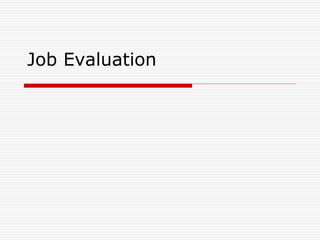
HRM-Job Evaluation.ppt
- 2. Job Evaluation Technique for comparing JOBS rather than employees. “system for comparing different jobs systematically to assess their relative worth, so providing a basis for a grading and reward structure”.
- 3. Job Evaluation Good remuneration systems must be seen as fair – especially by employees! The law also demands that jobs of equal worth should attract equal pay. A key factor in fairness will be linking the degree of difficulty of the job with the reward. Job evaluation can be used to assess the relative difficulty of the job.
- 4. Job Evaluation Methods A. Ranking method: The job ranking method arranges jobs in numerical order on the basis of the importance of the job's duties and responsibilities to the organization. This method, though easy to understand, is highly subjective in nature. B. Classification method: The job classification method slots jobs into . pre established grades. Higher-rated grades demand more responsibilities, tougher working conditions and varied job duties. This method is easy to understand and takes care of all relevant factors affecting the performance of a job. However, it is not easy to write all inclusive descriptions of a grade. Further, the method oversimplifies sharp differences between different jobs and different grades.
- 5. C. Factor comparison method: In this method, jobs are ranked according to a series of factors such as mental effort, physical effort, skill needed, responsibility, supervisory responsibility, working conditions, etc. pay will be assigned in this method by comparing the weights of the factors required for each job.
- 6. D. Point method: The point system of job evaluation uses a point scheme based on the compensable job factors of skill, effort, responsibility and working conditions. The more compensable factors a job possesses, the more points are assigned to it. Jobs with higher accumulated points are considered more valuable to the organization. Select key jobs Identify the factors to all identified jobs such as skill, effort, responsibility etc. Divide each major factor into a number of sub factors. Each sub factor is defined and expressed in order of importance. Find the maximum number of points assigned to each job Once the worth of a job in terms of total points is known, the points are converted into money values, keeping the wage rates in mind. Job Evaluation Methods
- 7. Job Evaluation Advantages Provides a systematic and rational procedure for valuing each job Ensures a degree of equity and objectiveness in remuneration Job descriptions generated are useful for other activities Helps motivation and morale Both employee and employer needs are addressed Scope for union/employee involvement
- 8. Job Evaluation Disadvantages Lack of allowance for differences in performance Assessment can be costly & time- consuming especially at the start Assessment can be inaccurate or approximate It’s still subjective!
